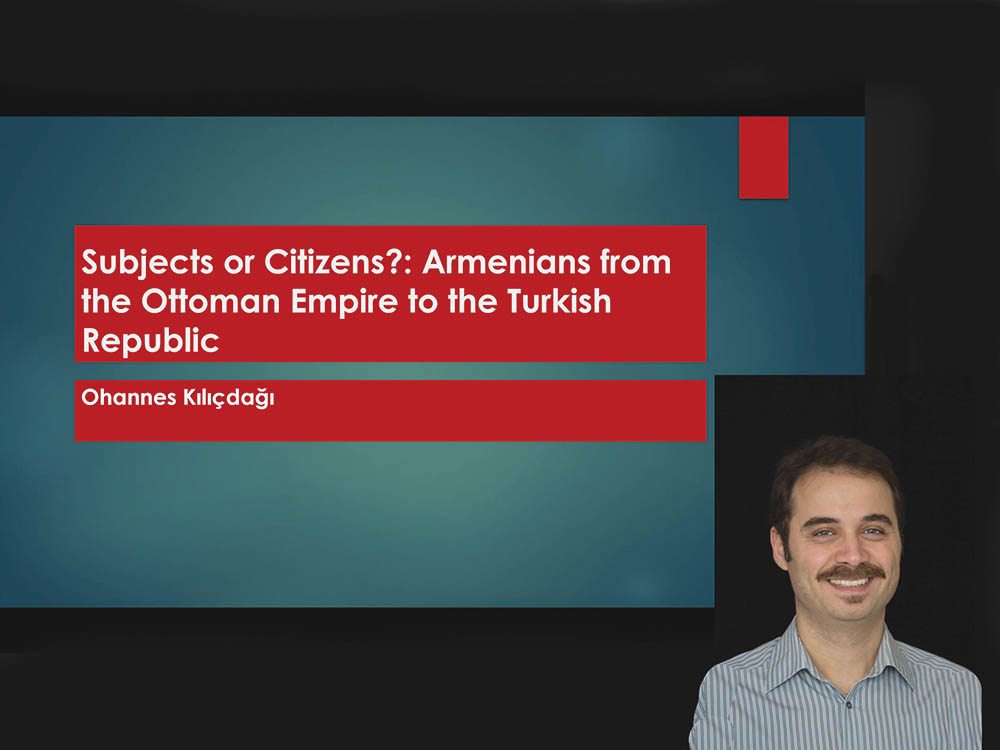
Arshak Abelyan
Staff Writer
The foundation of the new Republic of Turkey in 1923 presented a new challenge to the Armenian community in Turkey. The question was how Armenians and other non-Muslims should be defined under the new Republic.
Dr. Ohannes Kılıçdağı, 17th Kazan Visiting Professor of Armenian Studies during the Fall 2020 semester, presented his second lecture of three on the topic of “Subjects or Citizens?: Armenians from the Ottoman Empire to the Turkish Republic.” In his Friday, October 16, 2020, presentation, Dr. Kılıçdağı explored the relationship between the Christian population, specifically the Armenians, and the sociopolitical atmosphere surrounding the issue of minority relations within the newly founded Republic of Turkey.
Following the Armenian Genocide, the Armenian population in the Ottoman Empire had decreased by almost 94%. According to Dr. Kılıçdağı, by 1927 there were only 77,433 Armenians left in Turkey in 1927. Other Christian populations in Turkey were also affected. “Approximately 1.2 million Greeks were expelled from Anatolia, whereas approximately 400,000 Muslims were forced out of Greece and this was an agreement between Greek and Turkish states,” added Dr. Kılıçdağı. Were the Armenians going to remain subjects in the Turkish Republic as they were in the old Ottoman Empire or would a new relationship emerge?
Dr. Kılıçdağı explained that the population figures he collected were from the official census records of Turkey. The government used questions pertaining to mother tongue and religion to infer the identities of those who were Armenian. He also pointed out that in 1965, these statistics were no longer publicized and were kept classified. Later in 1985, “state security courts and the prosecutors of these courts opened a lawsuit against the coordinators of the State Institute of Statistics and accused them of separatism,” said Dr. Kılıçdağı. After 1985, questions regarding mother tongue and religion were no longer used in official censuses. Dr. Kılıçdağı argued that this is one of the reasons why there is uncertainty regarding the official population figures of Armenians and other Christians in Turkey today.
On the discussion of the reliability of these figures, Dr. Kılıçdağı stated that he was skeptical about several questions. One of the most surprising concerned the categorization of Armenian as a religion instead of it as an ethnicity or nationality.
Dr. Kılıçdağı laid out three possibilities on how the Republic of Turkey could move forward with describing, categorizing, and treating its Christian minorities. The first solution was to look back to the Ottoman millet system, which was used to categorize non-Muslim communities by religious categories. The second was the law of citizenship adopted by the new Republic, and the final possibility were articles related to the Treaty of Lausanne.
Under the Ottoman millet system “religious groups were given some collective group rights in their civil affairs and in family law such as issues related to marriage, inheritance, divorce, and also in cultural matters,” asserted Dr. Kılıçdağı. He also added that the leaders of the community were mainly religious figures who were expected to organize internal affairs within the communities. Essentially, they were “mediators” between the Turkish government and their own communities.
On the other hand, according to the modern law of citizenship, “State and citizen are supposed to be in a one-to-one relationship without any mediator, without any connector between state and citizen,” said Dr. Kılıçdağı. According to articles 37 to 45 of the Treaty of Lausanne, the equal treatment of Christians and Jews is guaranteed. “The Turkish state agreed that it would provide, or it would facilitate the development and maintenance of cultural and educational foundations of these people, including Armenians,” said Dr. Kılıçdağı. However, this did not happen.
According to Dr. Kılıçdağı “none and all” of these possible methods have been implemented or applied in the treatment of Armenians. For example, Turkish government officials meet with the representatives of the Patriarchate to discuss issues regarding or facing the Armenian community, but they still do not legally recognize the Patriarch. Dr. Kılıçdağı also provided more information on the attitude and actions of the Turkish Republic with regards to the Treaty of Lausanne. “As for the Treaty of Lausanne, the Turkish state has largely ignored it, and moreover, has violated its clauses. For example, leaving aside the provisions of facilitating the development of institutions of these communities, they have confiscated the properties of Armenian institutions,” asserted Dr. Kılıçdağı.
With the failure of the Republic of Turkey to take action to decisively address how non-Muslims would co-exist as equal citizens, the Armenian community in Turkey, more specifically Istanbul, was left endangered.
“The Turkish state has created a deliberate legal vacuum and administrative ambiguity in defining and treating Armenians, and in this way, it has facilitated the demise of Armenians as one of the non-Muslim communities in the republic,” concluded Dr. Kılıçdağı.
 Hye Sharzhoom Armenian Action
Hye Sharzhoom Armenian Action